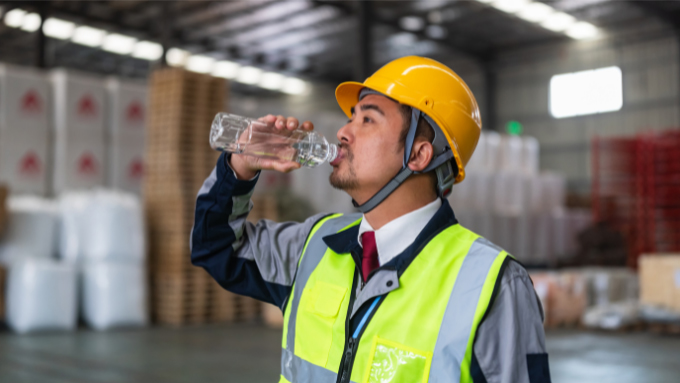Relationship within Hot Work Climate and Worker's Hydration Status: Literature Review

Downloads
Background: A hot working climate can result in excessive sweating so that it can cause dehydration in workers if it is not followed by adequate fluid intake. Workers with a hot work environment will interfere with the productivity of these workers.
Objectives: The focus of this literature review is to determine the relationship between hot work environments and workers' hydration status.
Methods: The journal articles reviewed were acquired from online databases such as science direct and google search without limitation of time and research results. The search for articles began on September 3 – September 15, 2022. Search for articles using the keywords "hot work climate, worker hydration status, heat exposure, hot work climate, hydration status”.
Results: Based on the selection process, 11 articles were found that were suitable and used a cross sectional design. The eleven research articles show link relationship between a hot work climate and the hydration status of workers covering various types of professions and employment opportunities, both indoor work and outdoor work. Most showed a significant relationship.
Conclusions: Therefore, it can be concluded that hot temperatures or hot working climates can be a risk of dehydration in workers. Therefore, work agencies are expected to be warry of the workers's hydration level, especially those exposed to heat in an effort to increase work productivity.
Amir, A., Ikhram Hardi S, & Sididi, M. (2021). Faktor Yang Berhubungan Dengan Kejadian Heat Strain Pada Pekerja Divisi Produksi PT. Industri Kapal Indonesia (Persero) Kota Makassar. Window of Public Health Journal, May, 785–796. https://doi.org/10.33096/woph.v1i6.228
Apriliana, D. . (2021). Hubungan antara Paparan Iklim Kerja Panas dengan Dehidrasi dan Kelelahan Kerja pada Tenaga Kerja Konstruksi di PT. PP Urban Proyek Rehabilitasi Pasar Legi Kota Surakarta. 1–21.
Arianto, M. E., & Dewi, D. (2019). Hubungan Antara Lingkungan Kerja Panas Dengan Keluhan Heat Related Illnes pada Pekerja Home Industry Tahu di Dukuh Janten, Bantul. Jurnal Ilmiah Kesehatan Masyarakat : Media Komunikasi Komunitas Kesehatan Masyarakat, 11(4), 318–324. https://jikm.upnvj.ac.id/index.php/home/article/view/39
Awwalina, I., Arini, S. Y., Martiana, T., Alayyannur, P. A., Dwiyanti, E., & Airlangga, U. (2022). Perceptions With Dehydrati on Incidence in Shipping Companies '. November 2020, 61–72. https://doi.org/10.20473/ijph.vl17il.2022.61-72
Bahrudin, M., & Nafara, A. B. (2019). Hubungan Dehidrasi Terhadap Memori Segera/Atensi. Saintika Medika, 15(1), 12. https://doi.org/10.22219/sm.vol15.smumm1.8487
Buanasita, A., Andriyanto, & Sulistyowati, I. (2015). Perbedaan Tingkat Konsumsi Energi, Lemak, Cairan, dan Status Hidrasi Mahasiswa Obesitas dan Non Obesitas (Difference of Consumption Level of Energy, Fat, Liquid and Hydration Status of Obese and Non Obese Students). Indonesian Journal of Human Nutrition, 2(1), 11–22.
Damasari, S. (2019). Hubungan Antara Iklim Kerja, Konsumsi Cairan dan Status Gizi dengan Status Hidrasi Pada Tenaga Kerja Bongkar Muat di Pelabuhan Pantoloan Palu. Universitas Tadulako.
Darmawan, A. B. (2013). Diet Sehat Air Kelapa. Media Pressindo.
Derbyshire, D., & Emma, E. (2013). Hydration and Urinary Tract Health.
Fadilah, D. L. (2022). Hubungan antara Heat Stress dengan Kejadian Dehidrasi pada Pekerja Outdoor Parkir dan Satpam Rumah Sakit Muhammadiyah Palembang. In Universitas Muhammadiyah Palembang. Universitas Muhammadiyah Palembang.
Fraser, C. (2009). The Importance of Monitoring Hydration Status in Our Clients. Wound Care Canada, 7(1), 18–20.
Habibati, A. F., Sa'adah, U. L., & Sulistyorini, L. (2022). Hubungan Asupan Cairan dan Iklim Kerja dengan Status Hidrasi Pekerja Home Industry Keripik Pisang Lumajang. Media Gizi Kesmas, 11(1), 95–101. https://doi.org/10.20473/mgk.v11i1.2022.95-101
Kenefick, R. W., & Sawka, M. N. (2007). Hydration at the Work Site. Journal of the American College of Nutrition, 26(October 2014), 597S-603S. https://doi.org/10.1080/07315724.2007.10719665
Leksana, E. (2015). Strategi Terapi Cairan pada Dehidrasi. Cdk-224, 42(1), 70–73.
Miller, V., & Bates, G. (2007). The consequences of environmental heat stress include a reduction in safety due Hydration of outdoor workers in north-west Australia. J Occup Health Safety ” Aust NZ, 23(1), 79–87.
Mulyono, M. (, December). Perlunya Pencegahan Heat Stress Dan Dehidrasi Pada Pekerja Di Bagian Mesin Casting Kontijensi. 2020.
Ningsih, N. K. (2018). Analisis Karakteristik Pekerja, Kondisi Fisik Lingkungan, dan Sanitasi Lingkungan dengan Tingkat Dehidrasi (Home Industry Pengasapan Ikan di RW 02 Kelurahan Kenjeran Kecamatan Bulak Surabaya). Universitas Airlangga.
Peraturan Menaker Nomor 5 Tahun 2018 Tentang Keselamatan Dan Kesehatan Kerja Lingkungan Kerja, (2018).
Puspita, A. D., & Widajati, N. (2020). Gambaran Iklim Kerja Dan Tingkat Dehidrasi Pekerja Shift Pagi Di Bagian Injection Moulding 1 Pt.X Sidoarjo. Journal of Public Health Research and Community Health Development, 1(1), 13. https://doi.org/10.20473/jphrecode.v1i1.20452
Rasyid, R. (2017). Paparan Iklim Kerja Panas Terhadap Status Hidrasi Pekerja Unit Produksi di PT. Argo Pantes Tbk Tangerang. Jurnal Teknik Mesin ITI, 1(1), 18. https://doi.org/10.31543/jtm.v1i1.11
Sari, M. P. (2017). Iklim Kerja Panas dan Konsumsi Air Minum Saat Kerja terhadap Dehidrasi. Higeia Journal Public of Health Research and Development, 1(2), 108–118.
Sari, N. A., & Nindya, T. S. (2017). Hubungan Asupan Cairan, Status Gizi Dengan Status Hidrasi Pada Pekerja Di Bengkel Divisi General Engineering Pt Pal Indonesia. Media Gizi Indonesia, 12(1), 47. https://doi.org/10.20473/mgi.v12i1.47-53
SHB, T., & Sudiajeng., L. (2004). Ergonomi untuk Keselamatan, Kesehatan Kerja, dan Produktivitas. Uniba Press.
Suma'mur. (1996). Keselamatan Kerja dan Pencegahan Kecelakaan. PT. Gunung Agung.
Sutarto, T., Soemarko, D. S., & Ichsan, S. (2022). The Association between Heat Exposure and Hydration Status Among Production Workers in Fish Processing Company. The Indonesian Journal of Community and Occupational Medicine, 1(3), 146–153. https://doi.org/10.53773/ijcom.v1i3.33.146-53
Tarwiyanti, D., Hartanti, R. I., & Indrayani, R. (2020). Beban Kerja Fisik dan Iklim Kerja dengan Status Hidrasi Pekerja Unit P2 Bagian (Wood Working 1) WW1 PT. KTI Probolinggo (Physical Workload and Work Climate Due to Workers Hydration Status Unit P2 (Wood Working 1) WW1 Section PT. KTI Probolinggo ). E-Jurnal Pustaka Kesehatan, 8(1), 60–65.
Wahyuni, A., Entianopa, & Kurniawati, E. (2020). Indonesian Journal of Health Community Info Articles. Indonesian Journal of Health Community, 1(1), 28–34.
Wiarto, G. (2013). Fisiologi Dan Olahraga. Graha Ilmu.
Copyright (c) 2023 Fedora Ivena Thom, Annis Catur Adi

This work is licensed under a Creative Commons Attribution-ShareAlike 4.0 International License.
Media Gizi Kesmas by Unair is licensed under a Creative Commons Attribution-ShareAlike 4.0 International License.
1. The journal allows the author(s) to hold the copyright and to retain the publishing right of the article without restrictions.
2. The legal formal aspect of journal publication accessibility refers to Creative Commons Attribution-Share-Alike (CC BY-SA).
3. The Creative Commons Attribution-Share-Alike (CC BY-SA) license allows re-distribution and re-use of a licensed work on the conditions that the creator is appropriately credited and that any derivative work is made available under "the same, similar or a compatible license”. Other than the conditions mentioned above, the editorial board is not responsible for copyright violations.



















